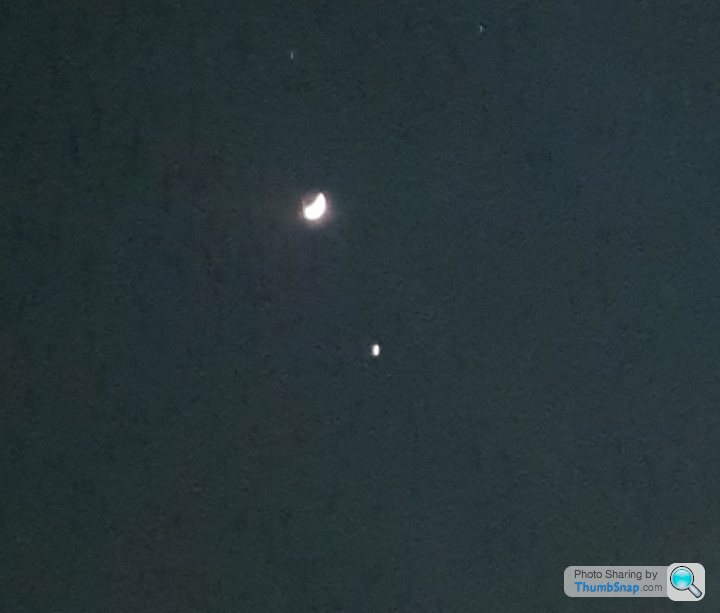Discussion
I'm in SW France.
About a hour ago I saw, in a clear sky, what I'd call a New Moon. Like a fingernail trimming.
I could also see the rest of the moon, as a slightly paler grey than the surrounding sky and, above that, a very bright star.
Just now, the star is still there. but the moon's gone. There is no cloud cover.
So what's going on? How long do I have?
About a hour ago I saw, in a clear sky, what I'd call a New Moon. Like a fingernail trimming.
I could also see the rest of the moon, as a slightly paler grey than the surrounding sky and, above that, a very bright star.
Just now, the star is still there. but the moon's gone. There is no cloud cover.
So what's going on? How long do I have?
When the moon is a very, very thin crescent, it can easily be obscured by haze or thin cloud in the atmosphere. As the moon sinks towards the horizon, you will be seeing it through denser atmosphere so it might appear to disappear.
The other part of the moon's disk that was vaguely visible would be the night side of the moon lit up by earthlight. It's some times referred to as "the new moon in the old moon's arms".

The other part of the moon's disk that was vaguely visible would be the night side of the moon lit up by earthlight. It's some times referred to as "the new moon in the old moon's arms".

Was going to start a new thread but this one will do.
I should know this as I'm a very sporadic astronomer but I don't.
The new moon the OP refers to was very high in the sky and tracking down to the horizon at an angle of about 30 degrees.
The full moon a mere two weeks later is skimming extremely low on the horizon.
I don't understand how the path of the moon across the sky can change so much in such a short period. I assume the moon's position is to do with the earth being on the wonk, but I can't understand why the moon's path wouldn't change very gradually over the year, rather than abruptly like this.
Can anyone explain?
I should know this as I'm a very sporadic astronomer but I don't.
The new moon the OP refers to was very high in the sky and tracking down to the horizon at an angle of about 30 degrees.
The full moon a mere two weeks later is skimming extremely low on the horizon.
I don't understand how the path of the moon across the sky can change so much in such a short period. I assume the moon's position is to do with the earth being on the wonk, but I can't understand why the moon's path wouldn't change very gradually over the year, rather than abruptly like this.
Can anyone explain?
Johnnytheboy said:
I don't understand how the path of the moon across the sky can change so much in such a short period. I assume the moon's position is to do with the earth being on the wonk, but I can't understand why the moon's path wouldn't change very gradually over the year, rather than abruptly like this.
Exactly this. The moon orbits the earth in a plane about 5° from the ecliptic. The earth's axis is inclined at 23.5° from perpendicular to the ecliptic. The moon orbits the earth every 29 days so you would expect its position to change a lot in two weeks.Gassing Station | Science! | Top of Page | What's New | My Stuff








